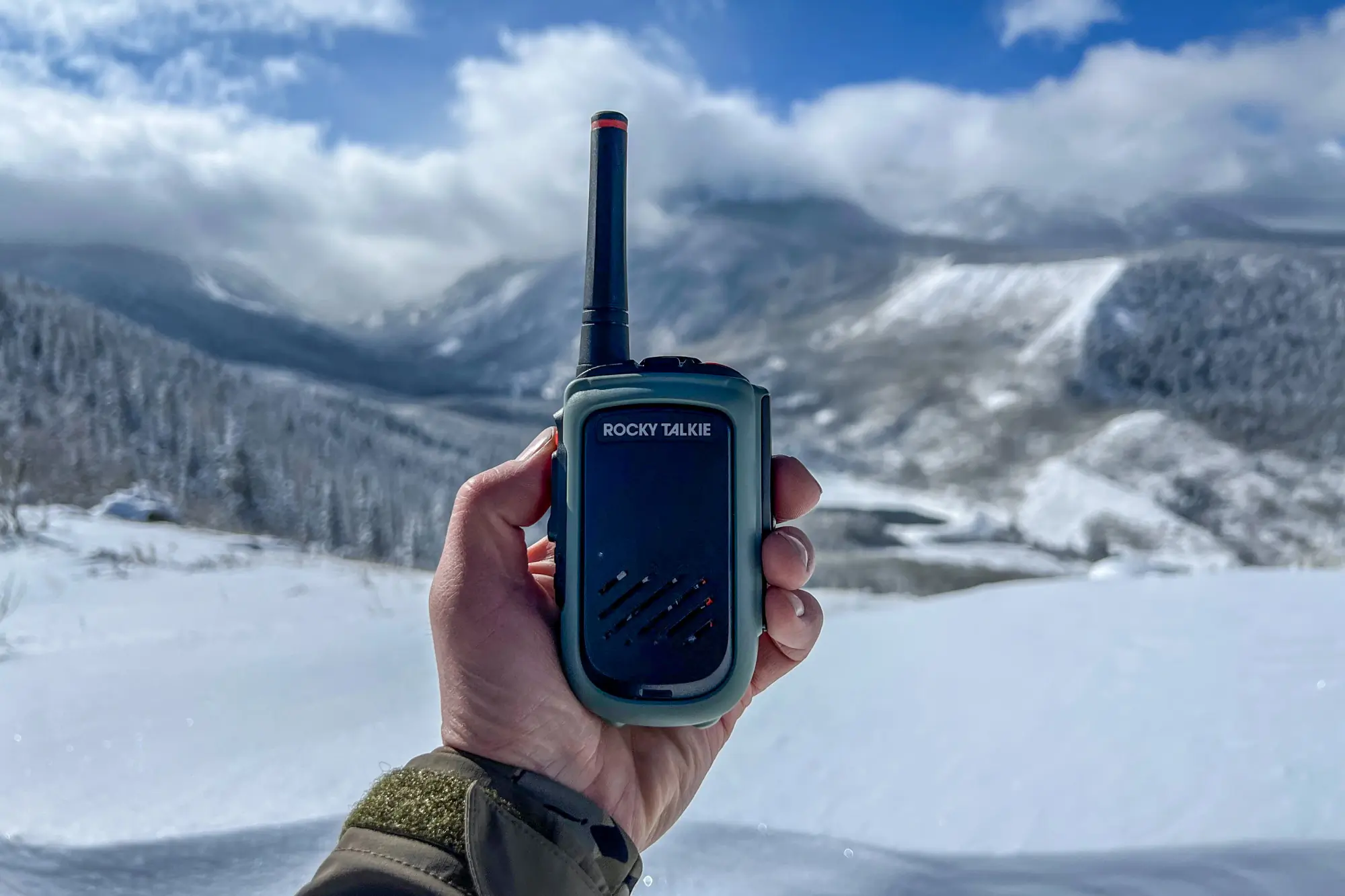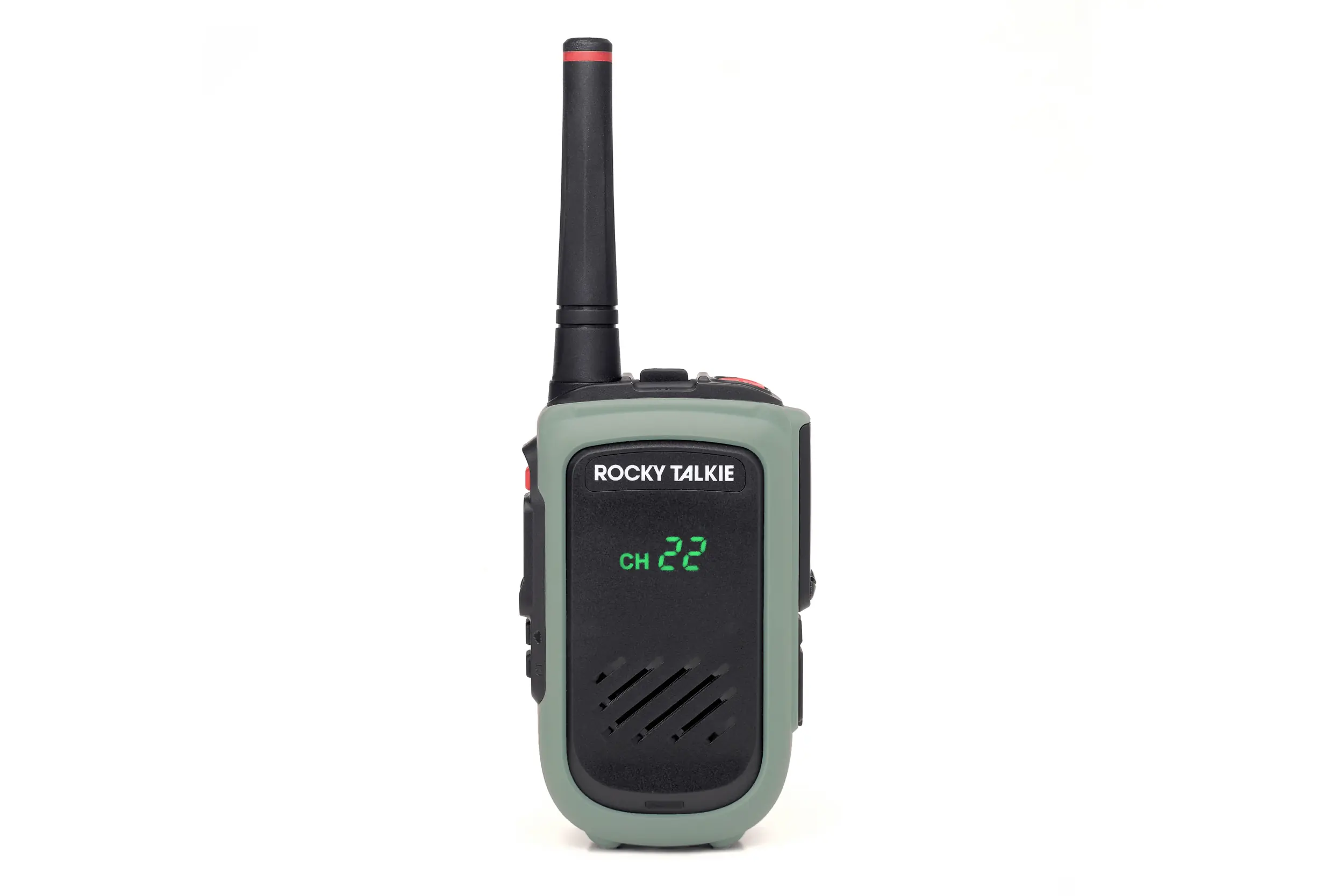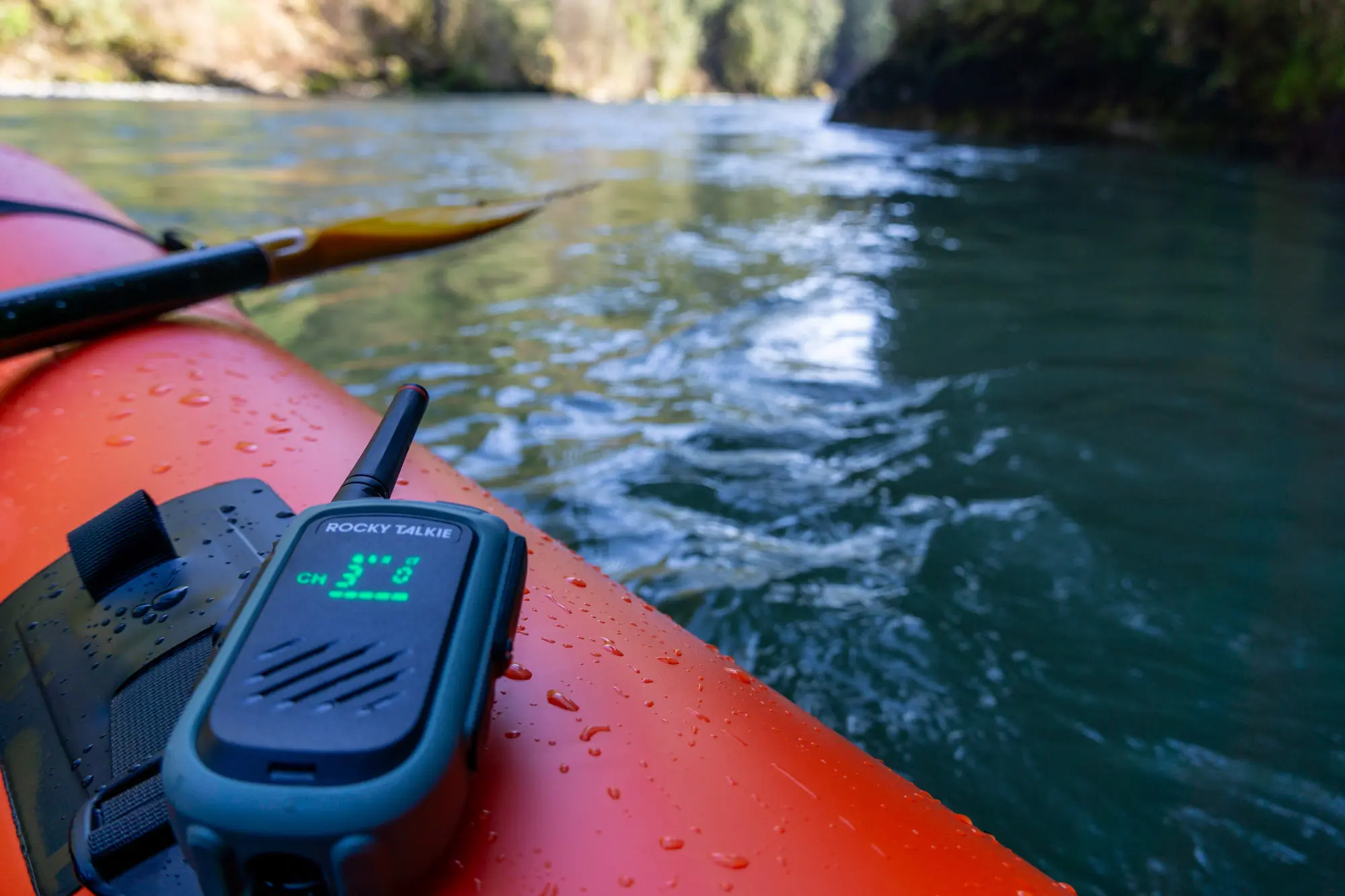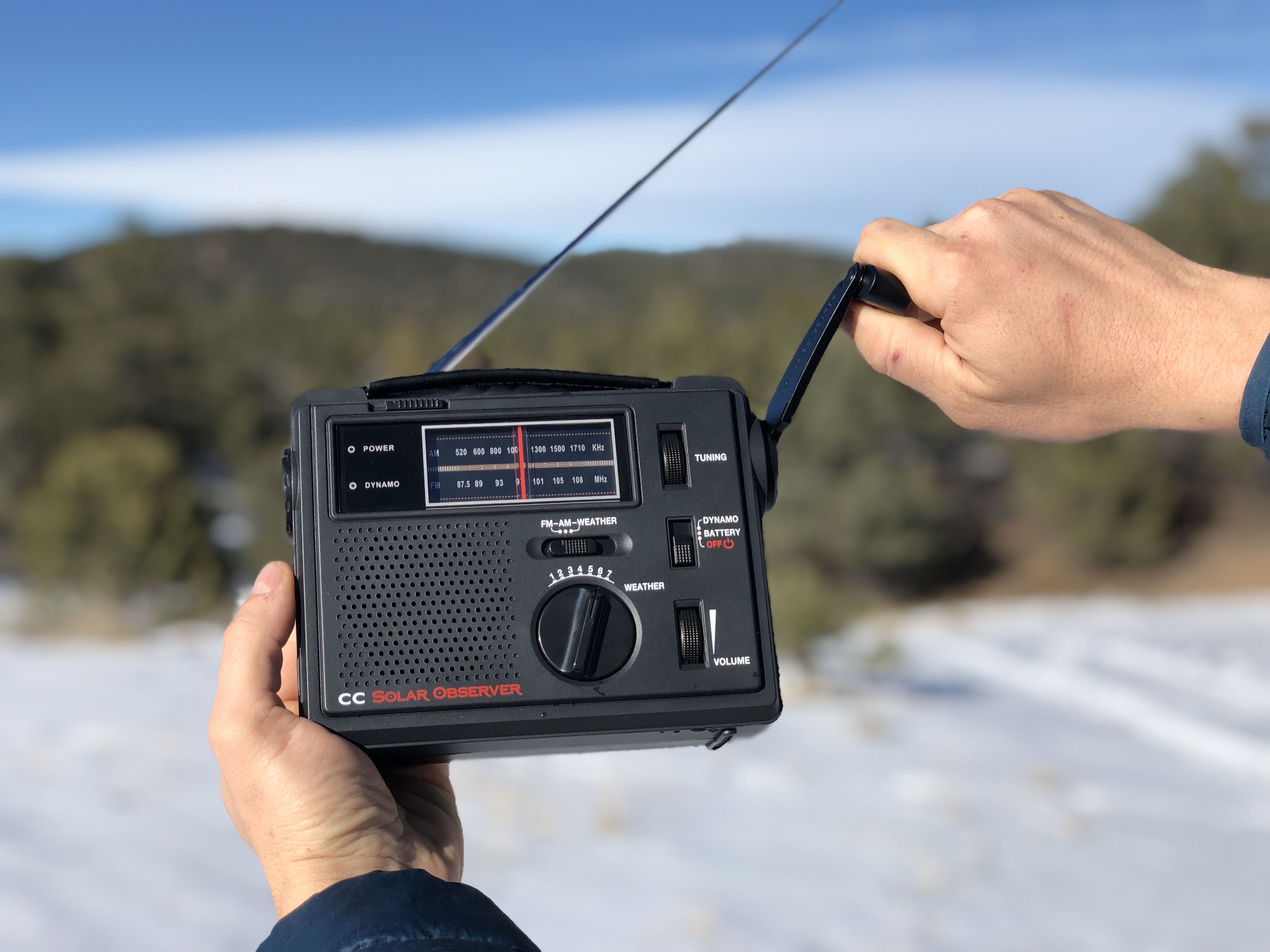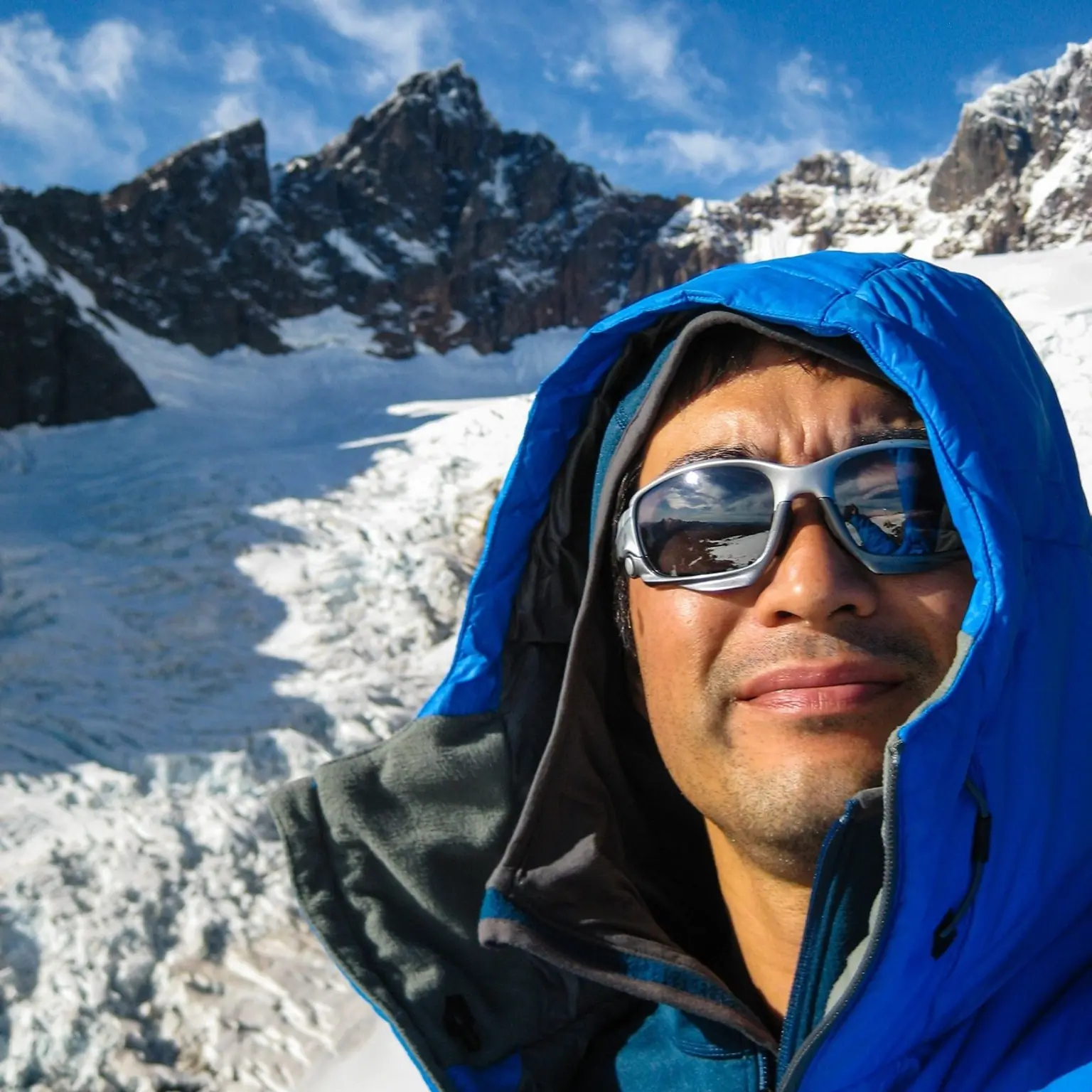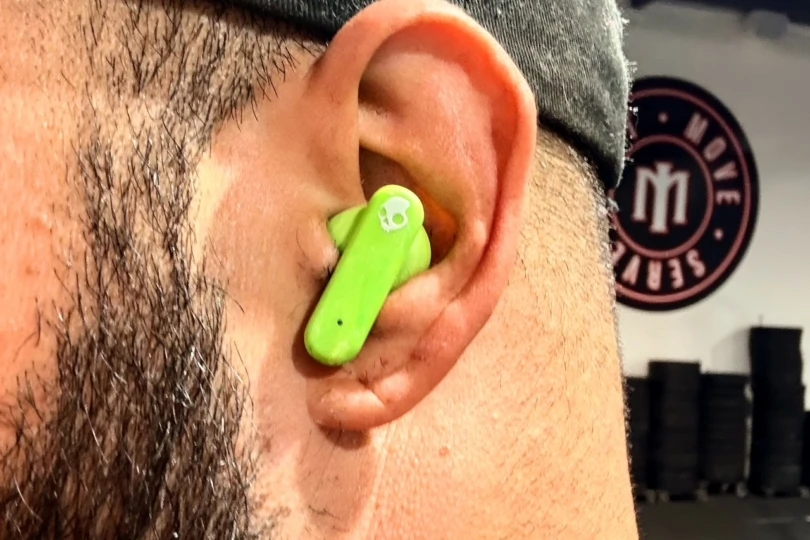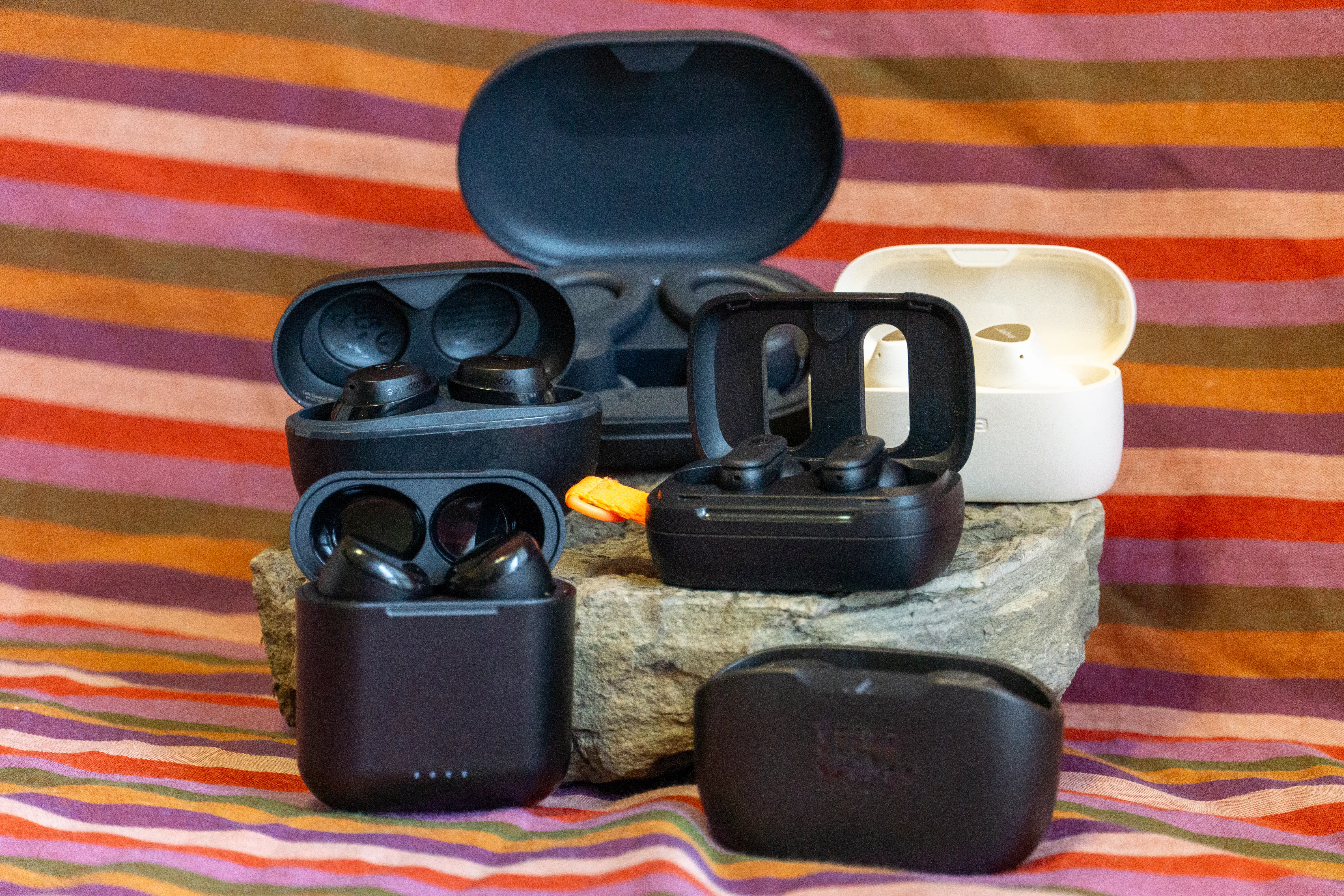Through the decades, I found reliable communications during multipitch climbs potentially life-saving and, at the least, injury-sparing. Although talking to my adventure partners has proven vital in other realms, it has proven a non-negotiable need in roped climbing. A simple miscommunication about climber anchoring status or other crucial information can quickly result in disaster.
I loved the Rocky Talkie Mountain Radio during a previous ice-climbing trip in Alaska. I found them robust and reliable. So, when the brand launched a more powerful version, I quickly snagged a pair for another foray into Alaska’s backcountry. I brought the Rocky Talkie Expedition Radio ($180 each) up every route over a week, along with the matching Waterproof Hand Mic ($65).
My team used the two-way radios during three extended outings in frigid weather, and we weren’t nice to them.
However, walkie-talkies are far from limited to the climbing niche. Thus, we also tested them in other popular pursuits, with editor Sean McCoy using them through a remote backcountry elk hunt and hiking in the Rocky Mountains. He also put them through some rugged use and had great success.
In short: The Rocky Talkie Expedition Radio provided consistently clear and reliable two-way voice communications over extended distances that often involved tree cover. The radios survived being packed with snow, impacts with ice and rock, and the general abuse that ice climbing and mountain elk hunting deliver to gear. The Rocky Talkie Expedition Radio and the Waterproof Hand Mic are now on the essential gear list for any backcountry climbing, hunting, skiing, or other endeavor that requires reliable communication.
Looking for a new walkie talkie? Check out how the Rocky Talkie Expedition Radio compares to the rest of the radios out there in GearJunkie’s Best Walkie Talkie Buyer’s Guide.
Editor’s Note: The Rocky Talkie Expedition was previously known as the 5-Watt Radio. We’ve amended our coverage to reflect the name change.
-
Range
9.0
-
Battery Life
8.0
-
Ease of Use
8.0
-
Weight & Size
8.0
- Radio Class: GRMS
- Channels: 22 + 8 repeater
- Privacy Codes: 121 (CTCSS and DCS)
- Frequency Range: 462 to 467 MHz
- Wattage: 0.5, 5 W
- Battery Capacity: Rechargeable 1,800 mAh Li-ion
- Dimensions: 7" x 2.2" x 2"
- Waterproof Rating: IP67 waterproof
- Weight: 9.4 oz.
Pros
- Extremely durable
- Impressive range, including use of GRMS repeaters
- Resistant to very cold temperatures
- Submersible
- Waterproof hand mic available
Cons
- Requires FCC license to operate
- More expensive than FRS radios
Rocky Talkie Expedition Radio Review
How Is the Rocky Talkie Expedition Radio Different Than the Mountain Radio?
The Rocky Talkie Expedition Radio costs $55 more than the Rocky Talkie Mountain Radio. For this price, the main upgrade is range. The Expedition Radio is classified by the Federal Communications Commission (FCC) as a General Mobile Radio Service (GMRS), while the Mountain Radio is a Family Radio Service (FRS) model.
GMRS and FRS operate across the 462 MHz to 467 MHz frequencies, but GMRS radios can use channels unavailable to FRS systems. And, as the product name suggests, the new Rocky Talkie amplifies the signal with 5 W instead of the 2W limitation on the FRS Mountain Radio. GRMS radios using channels commonly used in units like Rocky Talkies are limited to 5 W.

Another difference between the Rocky Talkie radios is that the FCC requires a license to operate the 5W GRMS radio, while it doesn’t enforce a license for FRS systems.
Finally, the Expedition Radio has a verified weight of 9.4 ounces each with an alligator clip (the hand mic is 5.6 ounces). In comparison, the Mountain Radio weighs 8 ounces with a carabiner attachment and leash.
What Happens If I Use the Expedition Radio Without a License?
By the letter of the law, the FCC can impose a $10,000 fine for transmitting a signal with a GRMS radio before obtaining a license.
The licensing procedure isn’t complicated. It involves an online application and a $35 fee for a 10-year license. The GRMS license covers the user and immediate family with no age restrictions.
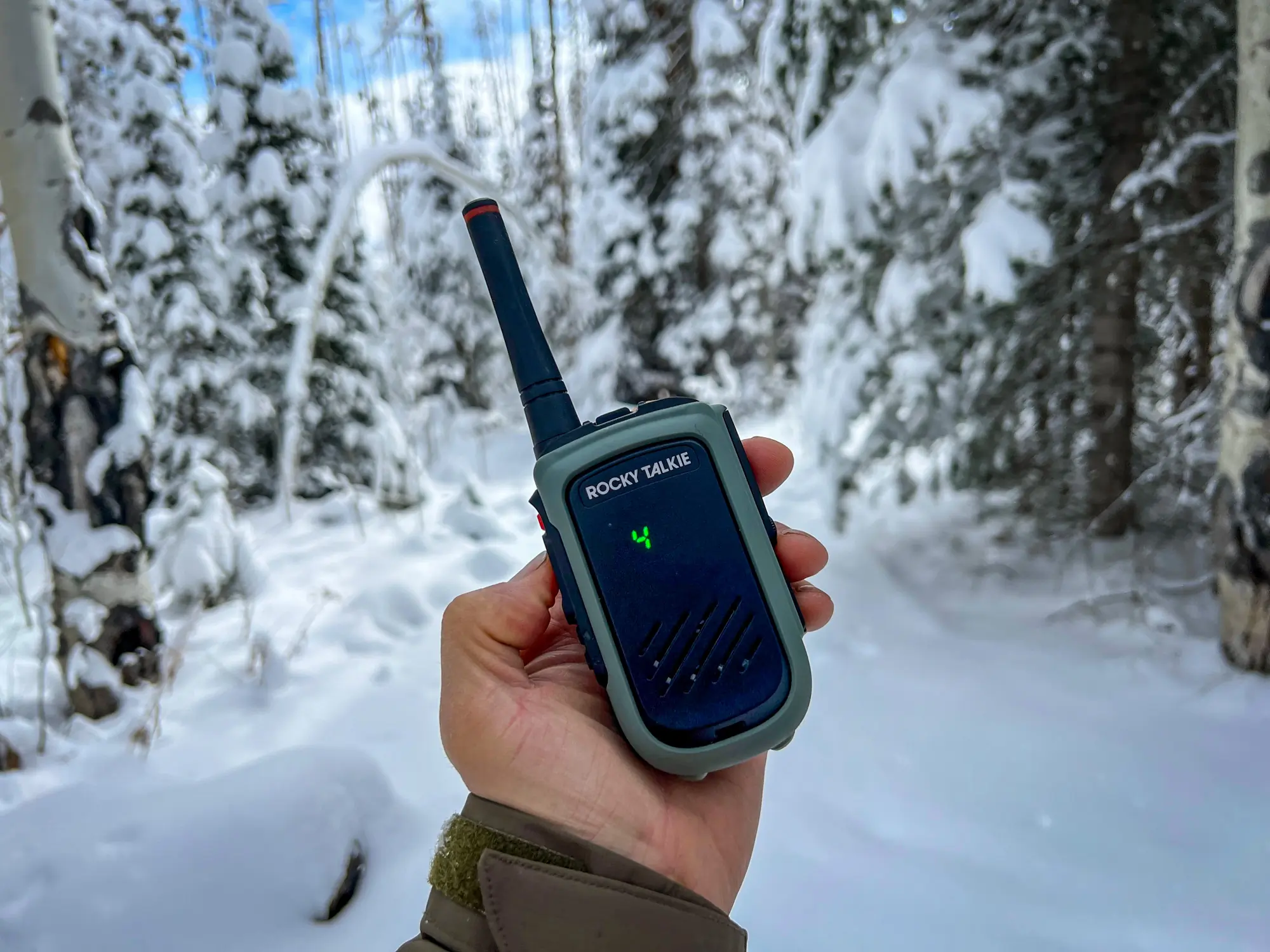
There are restrictions on the FCC GRMS license, including disclosure of any felony convictions, a minimum age of 18, and the applicant has to be an individual and not a business or a representative of a foreign government. But there is no test.
Rocky Talkie Expedition Radio Main Features
Most outdoors people looking beyond FRS radios are interested in the extended range of GRMS models. Rocky Talkie claims that its Expedition Radio has a maximum range of 35 miles, but in real-world outdoor adventure situations, 2 to 8 miles is typical.
The video below shows range testing in the field and describes factors affecting the range for the Mountain Radio and the Expedition Radio.
Rocky Talkie offers a longer 17 cm antenna to improve range over the standard 7.5 cm antenna.
Battery life is another significant factor for outdoor radios. The Rocky Talkie Expedition Radio uses an 1,800 mAh battery that the brand claims will last around 5 days, even in temperatures at -20 degrees Fahrenheit. Additional batteries are available if extremely long run times are desired.
The Expedition Radio has the standard features most adventurous types demand for their radios. A channel lock, high/low-power mode, and “Roger” beep help prevent communication mishaps. A scan mode can help in emergencies, while privacy codes protect transmissions from eavesdropping. The radio can also use GRMS repeaters on specific channels, dramatically extending the range.
The Expedition Radio provides quick access to 11 weather channels and NOAA weather alerts. A steel gator clip or an optional carabiner attachment secures the radio to backpacks, apparel, or harnesses. Finally, the radio is IP67 rated for waterproofness.
The Rocky Talkie Expedition Radio in Alaska, Colorado
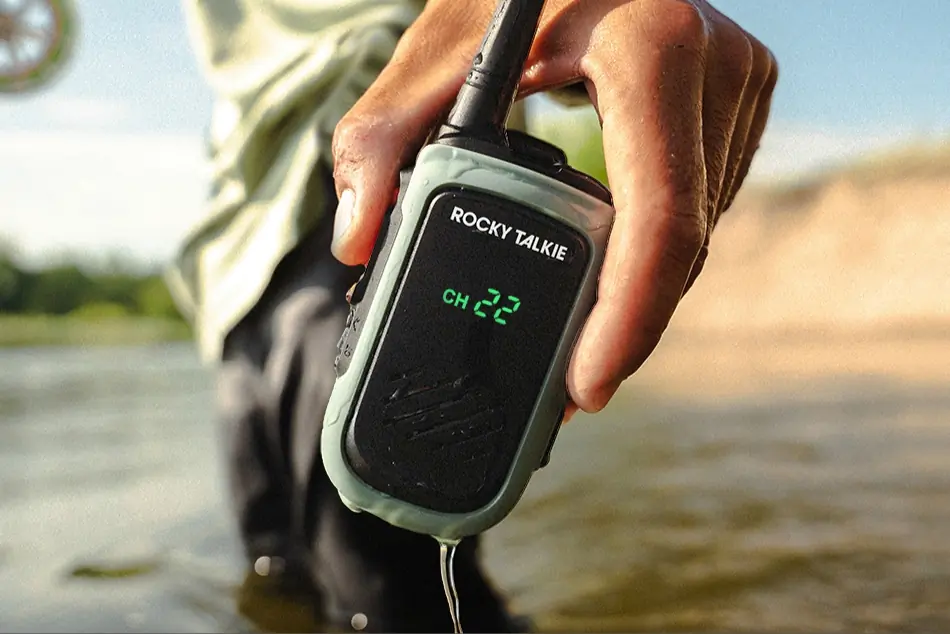



GearJunkie used the Rocky Talkie Expedition Radio with the Waterproof Hand Mic for three separate multipitch ice climbing missions this winter in Alaska. These outings involved ski approaches across frozen lakes, heavily wooded valleys, and ice-climbing routes up to 600 feet tall. The temperatures were always well below freezing, sometimes in the single digits or zero.
The radios were switched on for 6.5 to 7.5 hours per climb, and we never recharged them. The radios were clipped to either a backpack or climbing harness with the hand mic high on a shoulder strap.
GearJunkie’s hunting testers used the radios for more than 2 weeks during two backcountry hunts in the Colorado high country. Both hunts had periods of heavy snow and lots of moisture in the air and on the ground. The testers carried the radios in pants pockets and backpacks. They also left the radios powered on in camps during extended periods so their partners could monitor their progress.
Communicating on the Ice Routes
Communications started at the base of each route, with vital information passing between the lead climber and belayer. Almost every communication between the two was critical to safety. Signaling “on” and “off” belay was the most vital, as was the readiness of the lead climber and anchors to bring up the second and third climbers.
The lead climber also pointed out hazards, including falling ice and potentially loose ice blocks or lenses for secondary climbers to avoid. Finally, everyone checked in with their physical and mental condition as the hours on route progressed to stay on top of potential frostbite, bonking, and other cold injuries.
Every voice transmission from the bottom to the top of each route was clear, without any significant static. We found the Waterproof Hand Mic critical to our situation. It was consistently windy, and having both mic and speaker closer to an ear helped immensely. The push-to-talk button (PTT) at a shoulder strap made it easier to toggle while climbing and put the radio in a safer location.
We engaged the “Roger” beep, which gives an audible indication of pressing and releasing the PTT button. This was important as we always wore heavy gloves. The audible confirmation negated concerns about whether the transmission was completed.
Communicating During Elk Hunts
Hunters generally keep quiet during most of their time in the forest. Our team largely hunts alone throughout each day and doesn’t see each other until the evening when they return to camp. Thus, they check in a few times daily to monitor progress and ensure everyone’s safety.
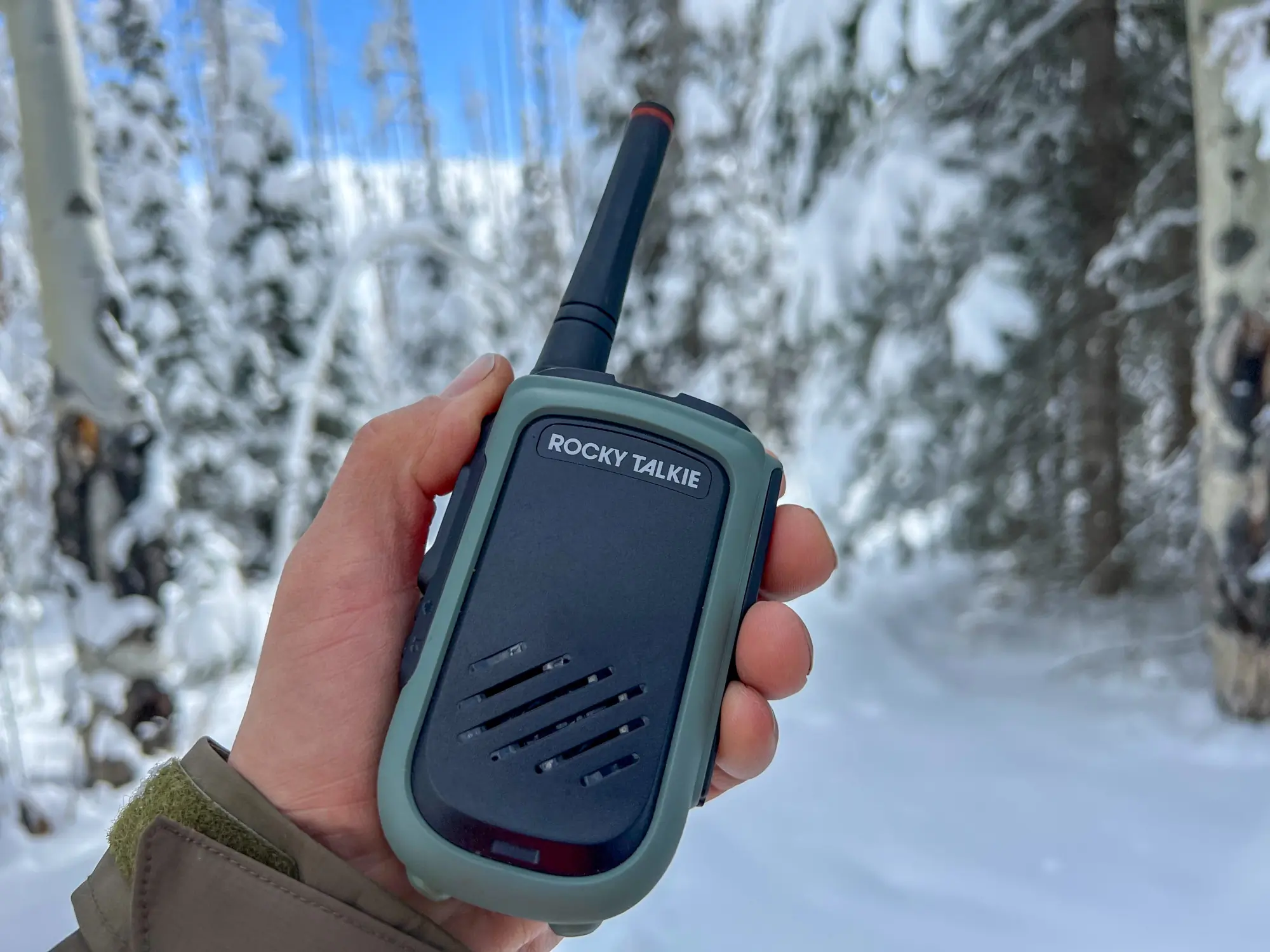



During our use of the radios, we ranged from a few hundred yards to a couple of miles away during communication. In almost every instance, we noted very clear, easy-to-understand conversations. It was remarkable that, even when whispering to keep noise down, we could communicate through heavy timber at ranges well beyond a mile through mountain terrain.
The hunt team chose to turn off the “Roger” beep, as it makes a loud and distinctly human sound that could frighten the game away. However, as the use is slower-paced during hunting, it didn’t result in any miscommunications. We loved the fact that you could turn it off.
Finally, the hunt team put the radios through some rough treatment. The radios were dropped into deep snow and mud puddles and left running in humid, hot tents. They worked like a charm outside of one instance when all comms dropped entirely during a conversation and didn’t return until hours later.
We discussed the issue with Rocky Talkie and ultimately traced it to a problem with our pre-production test units. It should not be a problem with any models on the market today.
Rough Treatment
I often looked down at the radio attached to my harness and saw it covered in snow and ice. Snow would be packed into every switch and indentation in the radio’s body.
But the Rocky Talkie Expedition Radio shrugged it all off. The radios never whimpered at the freezing temperatures or the occasional near-freezing water from drips or running down the surface of the ice formations.
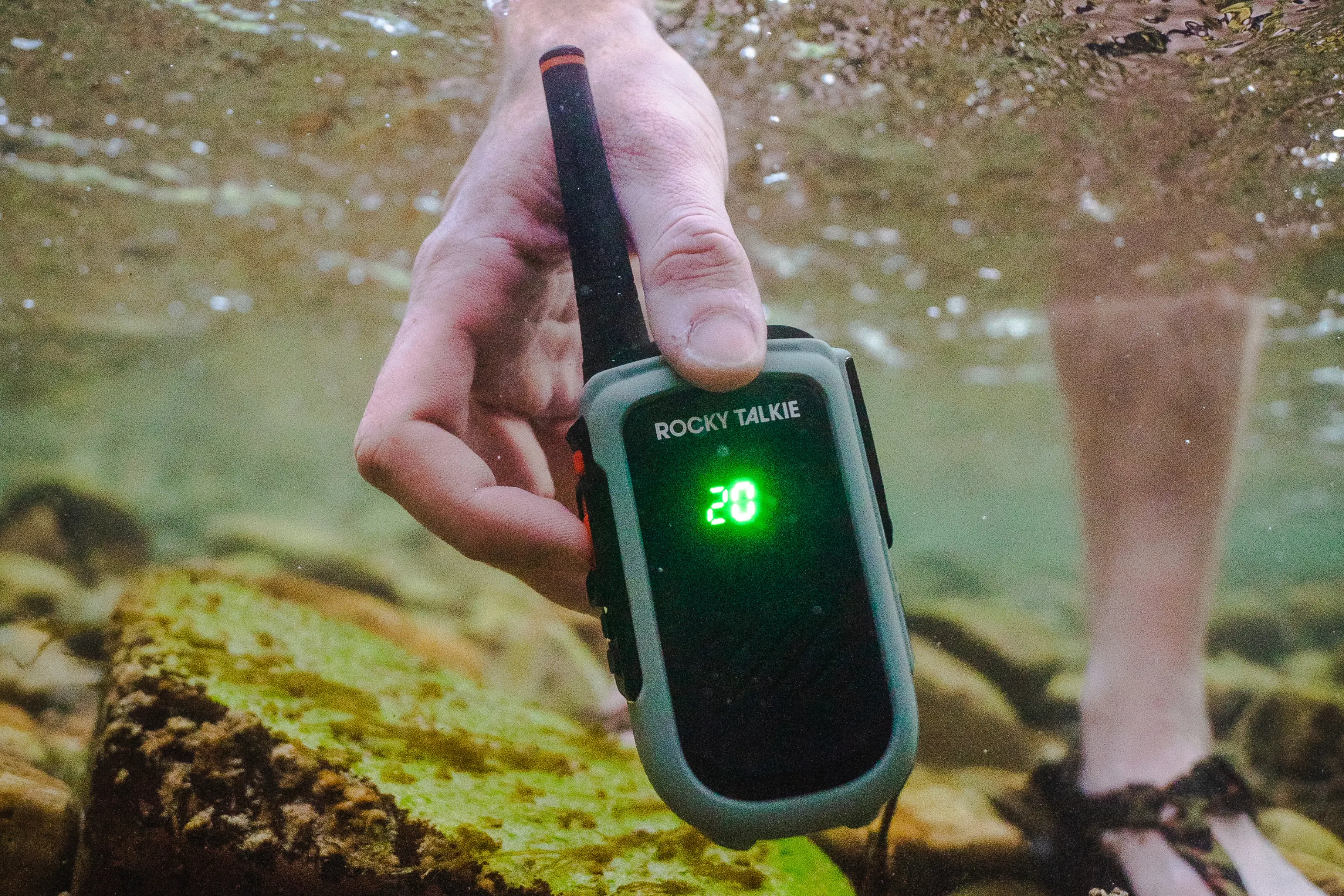



I also fell while seconding, with my leashed ice axe ripping the hand mic from my shoulder strap. My ice tool was dangling below me, supported by the coiled mic wire. I used the wire to retrieve my tool. No harm, no foul.
Finally, I dropped my radio on the ice or hard snow from my shoulder at the bottom of each route. They laughed at my efforts. These are seriously tough radios.
Battery Life
We ran the radios for 18 hours on the climbing trip. When I got home and powered up my two units, one radio showed 90% battery life, while the other displayed 85%. I didn’t come close to draining the batteries to even half capacity. This surprised me because of how cold it was and how often we transmitted over the week. It was a lot!
The hunt testers used the radios for short bursts over two 1-week periods. While the radios did not remain on for long periods, they did have regular conversations several times a day. After each week, the radios were still above 90% charged, even with use in subzero temps.
Conclusions on the Rocky Talkie Expedition Radio
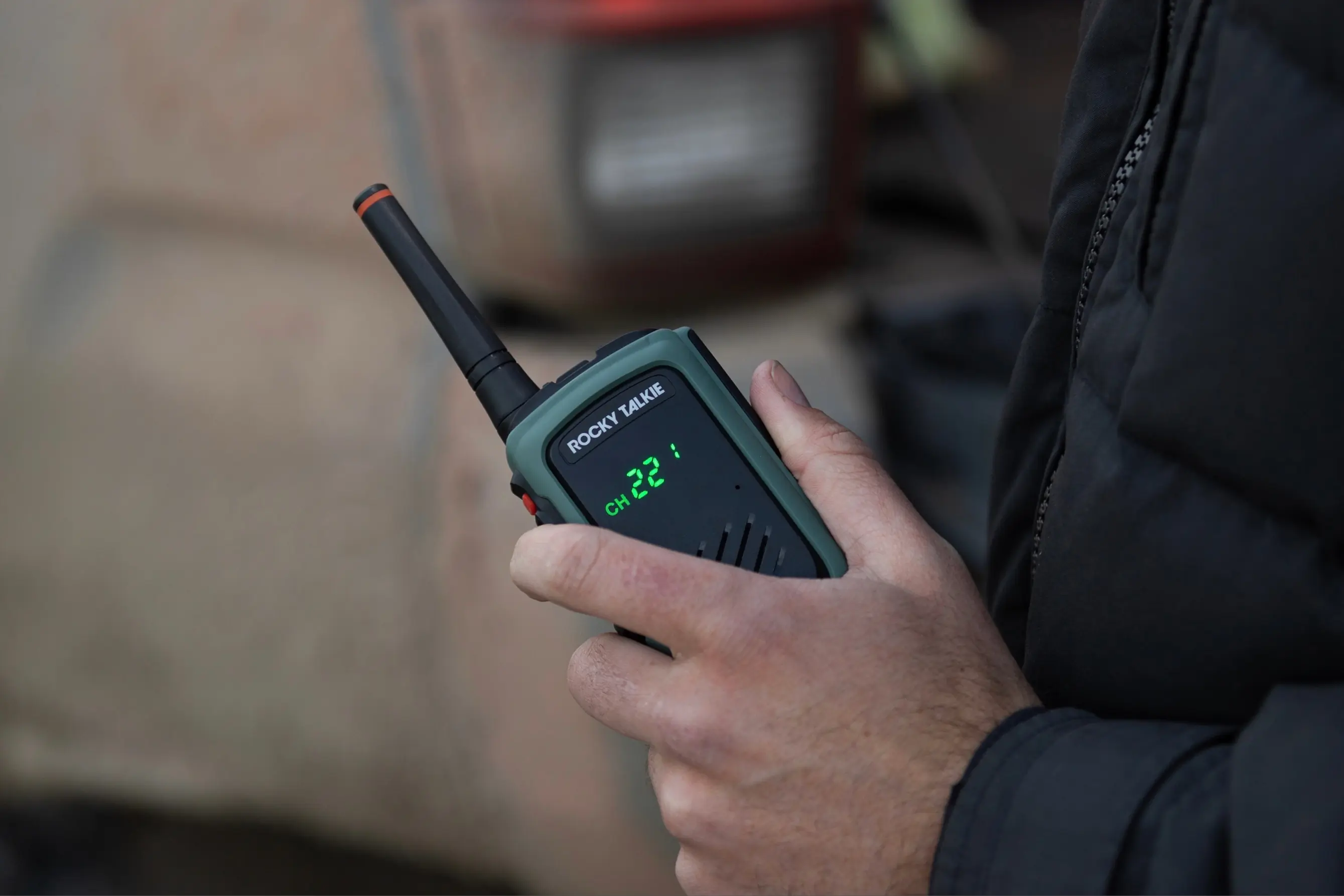



Although I never stressed the maximum range or battery life of the Rocky Talkie Expedition Radio, it was reassuring to know that I had both of these in spades. I consider that a great trade for the slight weight increase over the Mountain Radio.
The radios were treated astonishingly roughly in consistently below-freezing conditions, to no avail. Over the decades, I’ve destroyed many sets of cheaper, big-brand FRS radios, and I’m never going back. These radios were gladiators against poor treatment and environments.
Finally, knowing what I paid for each broken FRS radio in the bone pile, I feel the $180 price tag for the reliability and range of the 5W GRMS system is well worth it. It’s hard to put a price on total confidence in the ability to communicate when it really matters.
